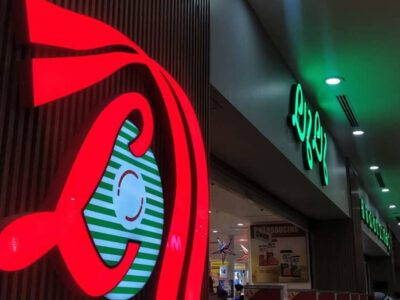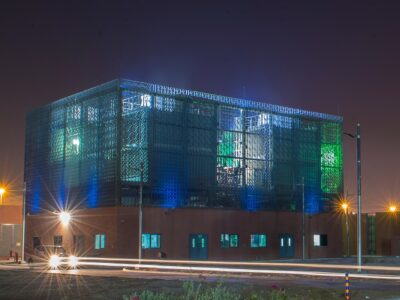Imagine a world where paying for cinema tickets took less than a second and you never had to queue for a burger again.
Well it may not be long before those dreams become a reality for consumers across the Middle East, thanks to the introduction of contactless credit and debit cards.
Contactless credit cards contain an in-built antenna and when the card comes within a certain proximity of the terminal it establishes a communication with the card.
The very latest in payment technology, contactless cards, allow customers to pay for items in less than a second by tapping their card against a reader at the cash till or simply passing it in close proximity across the reader.
The technology has already been widely deployed in 12 countries across the US and in parts of Europe and Asia and now MasterCard and Visa are gradually introducing it to the region’s banks.
Visa plans to launch its payWave contactless cards on a pilot basis later this year.
Meanwhile Emirates Bank has launched a contactless MasterCard credit card in partnership with Dubai Internet City (DIC) using MasterCard’s PayPass technology. Money spoke to the pioneers behind the introduction of the technology in the Middle East about their claims that it will make customers’ lives easier – and about how they will address security concerns about contactless cards.
How does it work?
While the concept of simply tapping your card against a reader and passing the card close to it in order to make payments at a cash till may sound a futuristic, alien concept, the technology behind it is in fact already widely used in shops and other outlets across the UAE.
Contactless cards work using radio frequency identification (RFID) – the same method used by shops to scan barcodes and the science behind Dubai’s Salik road toll. The technology uses radio waves to transmit signals between an RFID antenna built into a credit card or another object and a reader – such as a bar code scanner.
In the case of contactless cards, the antenna is embedded into the card and a payment is made when the customer transmits a signal between the card and the reader.
Anil Chander, head of the RAKBank’s cards business, explains: “Contactless credit cards contain an in-built antenna and when the card comes within a certain proximity of the terminal it establishes a communication with the card. The antenna in the card will catch the radio frequency from the reader at the till then complete the transaction. There is no customer verification needed – the customer does not have to give a signature or tap a pin number into the reader.”
It is precisely the lack of customer verification required for contactless credit card transactions that has raised security concerns from customers – and has created a need for card issuers to create strict controls around the use of contactless credit cards.
While traditional credit cards require customers to sign a credit card slip or enter a pin number before being able to make a payment nothing is needed from customers using contactless cards to prove their identity. This has raised strong suspicions from customers about what happens if their card is stolen – surely without the need for any customer verification thieves could just take the cards and use the cards at any outlet? To address those concerns card issuers are enforcing maximum spend limits on contactless credit cards. They are also enforcing a system whereby only a limited number of transactions can take place – before the card converts into a traditional credit card and the customer is asked for a signature or pin number.
Once this takes place the customer’s allocated number of transactions is replenished and the cycle starts again.
Of course if someone has their card stolen it could be used for contactless payments certainly but there is a limit and a cap on that spending before identification is asked for.
Similarly if the customer wishes to make a transaction above the maximum amount for contact-less payments – the transaction takes place as with a traditional credit card and the customer is asked for a pin number or a signature.
Emirates Bank is one of the first banks in the region to launch a contactless credit card – a DIC co-branded MasterCard for tenants and staff of DIC to use at outlets across the free zone.
Louis Scotto, general manager of retail banking at Emirates Bank, explains what measures have been put in place to protect the security of customers using the card.
“The limit that is set on the card is AED100 per transaction and customers can have up to three transactions using that limit. Then on the fourth transaction the merchant will treat it as a normal card to reset the security counter. Customers would then have to enter a signature or pin number in order for their payment to be accepted. This is basically a security device.
“Of course if someone has their card stolen it could be used for contactless payments certainly but there is a limit and a cap on that spending before identification is asked for.”
Sameer Govil, area manager for the Middle East at Visa, which plans to introduce its own contactless credit cards in the region on a pilot basis by the end of the year, adds: “Issuers and banks take the view that they must balance convenience and risk when it comes to contactless credit cards. The principle of setting a maximum spending limit for contactless cards is that it allows for the majority of transactions to take place offline.”
Another measure Visa has taken to further secure contactless cards is to introduce a mandate whereby the technology is only available outside the US on cards embedded with a chip – rather than, or in addition to, the traditional magnetic strip.
Chip cards are inherently more secure than magnetic strip cards as they are almost impossible to replicate.
“A chip card is very difficult to copy and one of the key reasons these cards have been introduced is to reduce fraud levels. Contactless cards in the US did not all embrace and leverage chip technology,” says Govil.
“Visa has mandated that outside the US, all issuers s have to use chip based cards f.”
Chander also points out that although contactless credit cards involve no customer verification for payments under AED100, the very fact that a customer does not have to hand the card over to a second party in order to make a payment makes the system more secure.
“The customer does not give the card to anyone – it remains in their custody. Traditionally, credit cards in many outlets are taken away and the customer briefly loses contact with that card. And during that time they really don’t necessarily know what is happening to that card.”
A chip card is very difficult to copy and one of the key reasons these cards have been introduced is to reduce fraud levels.
The use of contactless cards only for transactions of around AED100 or under means that they are best suited for outlets where customers tend to spend small amounts – such as fast food outlets or grocery stores.
Govil explains that Visa aims to specifically target those sorts of locations and to encourage merchants there to install readers.
“We do not foresee that all merchants will start deploying contactless card readers because the fact is that it would only be of use in locations where typically the merchants handle low value transactions.
“It would also be of use in locations where there is uniformity, where the majority of the transactions that take place are of a low value. We would not, for example, expect to see contactless card readers in jewellery stores – but we would certainly expect to see them at pharmacies for example.”
Scotto says he expects the biggest take-up of contactless card technology, from the point of merchants, to be in cinemas, coffee shops and fast food outlets.
“This technology has to be offered by merchants that have a vast majority of transactions under AED100. I mean you wouldn’t’ go into Tiffany and try to push a card reader there, where you couldn’t even buy a box for AED100. With our DIC co-branded contactless card we have established partnerships with Costa Coffee and Subways as well as several other individual vendors,” he goes on to say.
Such partnerships between banks and retailers are vital to the success of contactless credit cards in the UAE as the technology will not be widely adopted unless retailers install card readers in their stores.
So far though the signs are looking positive. According to Robin Mukherjee, head of cards business at Emirates Bank, there are around 240 outlets in the UAE that are equipped to process contactless card payments.
“MasterCard have said there are approximately 240 outlets in the UAE that are or will be in a short while, capable of accepting contactless transactions and tens of thousands of outlets across the world. As soon as merchants start to see the benefits of this technology, more of them will come on board,” he adds.
Govil says Visa’s aim is to have hundreds of retail locations across the UAE where card readers have been set up by the end of the year: “We will certainly have a few hundred locations by the end of the year for the pilot project we are planning to carry out and we want to have a representative sample across merchant segments,” he adds.
He believes that the early signs of a positive response from retailers towards contactless credit cards is because of the clear benefits the technology holds for them.
One of the biggest benefits is the ability to process payments quickly, eliminating queues.
One of the fundamental driving factors behind the introduction of contactless credit cards in the region is to replace cash behaviour.
“Speed is the greatest benefit of contactless technology because retailers are able to conduct transactions in a far faster turnaround time,” says Govil.
“For the merchants, especially for the likes of McDonald’s where the serve time is a clear determinant of profitability, this can be a huge benefit. If fast food restaurants like McDonalds can reduce their cycle time by 10% they can obviously serve more customers and their profitability is driven by that,” he adds.
Another advantage to merchants of customers paying for small ticket items using contactless credit cards is that processing and handling cash costs retailers money, as Scotto explains.
“Contactless cards are very beneficial to merchants because they don’t have to pay an employee who will take the card, run it through the swipe machines, press buttons, hand over the receipt to be signed then take it back.
“Processing cash is a labour intensive service and there’s also the security issue of keeping cash in the outlet. On top of that the more money there is in the cash tills the less money is going into the merchants’ bank accounts so the less money that they can invest.”
Chander adds: “One of the fundamental driving factors behind the introduction of contactless credit cards in the region is to replace cash behaviour.
“All the stakeholders have a lot to gain by moving payment methods from cash to cards. Cash causes a lot of problems for merchants in terms of security, processing the cash, counting it at the end of the day and the cost of insurance.”
As well as acceptance from the merchants customers need to embrace the technology in order for it to be a success.
Visa has conducted extensive market research to find out customers’ views on contactless cards in the UAE and what concerns they have.
According to Govil, those who took part welcomed the introduction of innovative new technology but had various security concerns.
“Two months ago we organised focus groups in the UAE and we had close to 600 respondents taking part,”he says.
“There were three key themes that emerged from the research. The first was around innovation – and actually what came out was that consumers love to have innovative products. The underlying technology behind contactless credit cards is exciting and the consumers we spoke to want to be a part of it. The second theme was that customers were a bit sceptical about risk and security. Customers were concerned that this was a less secure payment method because they were just tapping the card against a reader.
“Another concern was over the possibility of accidentally tapping the card twice against the reader. Customers wanted to know if this mean they would be debited twice for the payment?
“A couple of respondents wondered whether if the card was in their wallet and they passed close to a reader in an outlet they would accidentally make a payment.”
Answering these concerns, Govil says that no second transaction can take place in quick succession after the first as the first payment must be fully processed first.
And accidentally making a payment by walking past a reader is unlikely, as the card has to be within 4 to 6 centimeters of the reader in order for a transaction to take place.
But while he claims such concerns by customers are generally unfounded, Govil admits that there’s still much to be done to educate customers about the benefits of contactless cards before they can really take off in the UAE marketplace.
“We don’t have any doubts about the success of Visa payWave.
“But we want to make sure that we haven’t missed a trick from a local point of view when it comes to adoption of cards in the region.
“There will be substantial efforts to educate customers and vendors and we are going to work with banks to make sure they are ready to do that.
He adds that while strong security standards have been set for the contactless credit card, the technology is continually evolving to create even more secure products.
“The standards for these cards are evolving constantly.
“A contactless payment standard has evolved and it’s still evolving,” he adds.
Scotto however, is in no doubt about the potential for contactless credit cards and believes that a product which means skipping queues and getting what they want in seconds, will simply make perfect sense to customers: “The most important thing for customers is to see the immediate benefits to them.
“And if someone is standing in a long queue and they see a guy walk straight up to the reader, tap his card on a reader, then he’s out of the door, that person watching will think, ‘I want that card'” he goes on to say.”
Radio-frequency identification (RFID) is an automatic identification method which relies on storing and remotely retrieving data using devices called RFID tags or transponders.
An RFID tag is an object that can be applied to or incorporated into a product, animal, or person for the purpose of identification using radio waves.
Some tags can be read from several metres away and beyond the line of sight of the reader.
Most RFID tags contain at least two parts. One is an integrated circuit for storing and processing information, modulating and demodulating a (RF) signal and can also be used for other specialised functions.
The second is an antenna for receiving and transmitting the signal. A technology called chipless RFID allows for discrete identification of tags without an integrated circuit, thereby allowing tags to be printed directly onto assets at a lower cost than traditional tags.
RFID tags come in three general varieties: passive, active, or semi-passive (also known as battery-assisted).
Passive tags require no internal power source and are only active when a reader is nearby to power them), whereas semi-passive and active tags require a power source, usually a small battery.
What it is used for?
Passports
RFID tags are being used in passports issued by many countries. The first RFID passports, also known as e-passports were issued by Malaysia in 1998.
In addition to information also contained on the visual data page of the passport, Malaysian e-passports record the travel history (time, date, and place) of entries and exits from the country.
Transport payments
Throughout Europe, and in particular in Paris in France (system started in 1995 by the RATP), Lyon and Marseille in France, Porto and Lisbon in Portugal, Milan and Torino in Italy, Brussels in Belgium, and the London Underground.
RFID passes are used for public transport systems. They are also used now in Canada (Montreal), Mexico, Israel, Bogotá and Pereira in Colombia, and Stavanger in Norway.
Automotive
RFID tags are used in long range access control for vehicles. Since the 1990s RFID tags have been used in car keys. Without the correct RFID, the car will not start. Ford, Honda, and several other manufacturers use RFID-equipped ignition keys as anti-theft measures.
RFID in libraries
This technology has slowly begun to replace the traditional barcodes on library items (books, CDs, DVDs, etc.). The RFID tag can contain information, such as a book’s title or material type, without having to be pointed to a separate database.
Visa payWave
Fact sheet
As technology evolves at an ever-increasing pace, the concept of credit card payment is expanding beyond swiping or dipping a card through a point-of-sale reader. The proliferation of smart devices and the widespread availability of wireless connectivity technology have paved the way for a new wave of payment which enables secure transactions and value-added services on the move.
By leveraging the latest chip and wireless technologies, Visa has created Visa payWave.
What is Visa payWave?
Visa payWave is a form of contactless payment that removes the need to physically swipe or insert a smart card into a payment reader. By simply holding the Visa payWave card within 4 cm of the reader, the card will be detected and the transaction made. Visa payWave is a fast and simple way for consumers to make payment. Visa payWave merchants are able to accept payments in as little as four to six seconds, including the printing of the receipt.
This compares favourably with cash payments, which typically take between 12 and 14 seconds, from handover to hand back.
No signature is required and there is no need to even hand the card to the cashier – consumers simply wave, pay and go.
The Visa payWave card builds on the existing global EMV smart card standard that is currently being adopted by card issuers and acquirers around the world.
Payments are made via Radio Frequency (RF), much like the ‘tap and go’ cards that Singapore consumers are already familiar with from the MRT system.
There is an antenna – a thin copper wire inside the Visa payWave card that transfers payment information quickly and securely through the RF signal to a reader connected to the merchant’s point-of-sale terminal.
The benefits
For consumers
• Requires no signature and no card exchange at the point-of-sale.
• Empowers cardholders with a convenient and flexible payment option for goods and services.
• Functions as a 3-in-1 card: Visa payWave can be used not only as a contactless card at places where the Visa brand mark and contactless indicator is displayed, but also as a regular Visa card which is accepted around the world.
• A survey of 100 customers who use Chinatrust Commercial Bank’s Watsons co-branded contactless credit card revealed that 92% of them cited the convenience, speed and novelty of the Visa contactless technology feature as the main reasons why they liked and would continue using the card1.
For merchants
• Provides greater speed of handling payments, allowing staff to attend to other customers more quickly. Cashiers at Watsons indicated Visa’s contactless technology was convenient for them as they did not need to process cash or card and only needed to hand back receipts to customers.
• Feedback from contactless card users in Malaysia was that the absence of signatures and the need to rummage for change delivered a faster and more convenient experience in shops and other outlets.2
• By leveraging the industry-wide standard for smart cards, EMV acts as a powerful tool against counterfeit fraud
• Is expected to enhance customer satisfaction with a modern, fast and convenient way to pay, to help bring about greater customer spend and loyalty.
• Watsons indicated that their co-branded card equipped with Visa’s contactless technology garnered an average individual transaction amount of US$28, almost three times that of the average Watsons individual transaction which was about US$10.
For financial institutions
• Enhances their offering to their customers – cardholders and merchants alike – with a new, fast, smart and convenient way to complete a transaction
• According to Chinatrust Commercial Bank, cardholders using cards with Visa contactless technology spent an average of 53% more than cardholders that were not.
• Grants access to new merchant categories – (eg) quick service restaurants and other ‘low ticket’ merchant segments that have previously only accepted cash for payment.
• Leverages the full benefits of EMV global smart card technology
Technical features
• Contains a Visa Smart Debit Credit (VSDC) chip and therefore functions as full Visa credit/debit card
• Builds on the global EMV smart card standard
• Uses a dynamic cryptogram to uniquely identify and secure every transaction using EMV card authentication standards (dynamic data authentication or DDA)
• Combi card: single chip with dual contact and contactless interfaces, ISO/IEC14443 (A/B)
1Chinatrust Commercial Bank (CTCB) surveyed 100 Watsons customers who have the CTCB-Watsons Visa card, of which 50 had used the contactless technology function of the card before and 50 had not.
2The Visa Smart Card Deployment Study in Taiwan and Malaysia was conducted by Deloitte in 2006 where Deloitte surveyed 36 executives from various banks, merchants and vendors involved in the deployment of Visa Wave programmes.
Purchase power







